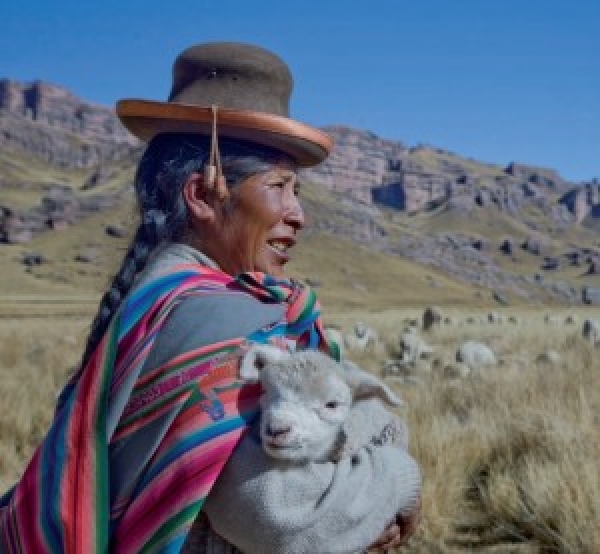Climate Refugees from the Peruvian Andes

Two recent studies offer complementary accounts of the ways that glacier retreat and other impacts of climate change have displaced indigenous people from their communities in the Peruvian Andes. One describes the people who have left as refugees, the other as migrants. Both emphasize the seriousness and apparent irreversibility of this large population movement
Teófilo Altamirano’s book,Environmental Refugees: Climate Change and Involuntary Migration, draws on methods and concepts from anthropology to explore displacement from a glacier region in central Peru. It links glacier retreat in the Peruvian Andes with other impacts of climate change, particularly the increasing variability of precipitation. Altamirano, a professor at the Pontifical Catholic University of Peru, focuses on Huaytapallana, a glaciated mountain about 5500 meters in elevation, located roughly 20 kilometers to the northeast of Huancayo, a large city in the central highlands of Peru. In the local Quechua language, the mountain’s name means “the place where wildflowers (huayta) are gathered (pallay)”—a reference to the meadows that are fed by glacier meltwater. Its glaciers have lost 55% of their area since the mid-1980s, according to a study published recently in Global and Planetary Change.
This region has experienced swings between periods of heavy rain and periods of drought, both of which reduce the yields of traditional agriculture, whether rainfed or based on irrigation. Altamirano links what he terms “water stress” to food insecurity, which is one of the strongest drivers of migration. He recognizes other drivers as well, particularly changes in the employment structure in Peru and increasing demand for labor in the United States, and pollution from mines. Nonetheless, he emphasizes the decline of local agriculture and food security as a major cause of outmigration. He notes that young adults are the most likely to leave; this age-specific migration depletes the local population of individuals most capable of agricultural labor, and adds to the vulnerability to droughts and to food deficits. Faced with these difficult circumstances, many households encourage the young adults to travel to areas where they can earn wages and send remittances home that can compensate for the decline in local agriculture, creating a vicious cycle of dependence on migration.
Altamirano’s book includes a cultural account of the community’s connection to the glacier. The local residents recognize the mountains as powerful beings, and honor them in rituals held every year. The most important festivals take place on 21 June, close to the winter solstice in the Southern Hemisphere, and on 25 July, linked both to the Catholic saint Santiago and to traditional Andean thunder deities. These events, both lasting several days, consist of pilgrimages from local villages to places close to the glaciers, where the participants bring offerings—candles, fruits, and drinks—to the spirits. They perform traditional dances and consume ritual meals.
In the first phases of outmigration, the migrants could contribute to the festivals, sending money home to provide for dancers, food and drink, and returning to participate in the rituals that demonstrated their respect to the mountain spirits. But the lengthy periods of migration can weaken these ties, and the visible retreat of the glaciers also can threaten the rituals which link between the communities and the mountains.
Altamirano uses the term “climate refugees” to refer to the people who have left this region permanently, driven by environmental factors that undercut traditional livelihoods and by the decline of the culture and rituals that had linked earlier generations to the mountain landscape. He draws parallels with other high mountain regions as well, particularly the Himalayas, where environmental and cultural processes have contributed to an outmigration that has severely weakened local communities.
A second study of the same region, “Where the Rain Falls: Climate Change, Food and Livelihood Security, and Migration,” draws on quantitative methodologies from geography and sociology to examine the same process, outmigration, from the same region. In this report, sponsored by CARE and the United National University, Koko Warner, an economist at United Nations University, and her coauthors include the Huaytapallana region in a set of eight case studies from Latin America, Asia and Africa. Like Altamirano’s study, this report indicates glacier retreat and increasing irregularity of rainfall as the principal impacts of climate change, though they mention other effects as well—a general decline in precipitation, and an increase in frost events. They also point to the weakening of traditional agriculture as a cause of outmigration, and indicate that young adults are the ones most likely to leave. They focus entirely on livelihoods strategies, emphasizing environmental factors.
Drawing on 150 household surveys and 23 workshops in three communities in different ecological zones in the region, this second study indicates that migration varies by elevation. The residents of the lower communities in the valleys, where cultivation of maize and potatoes are the principal activities, engageeither in short-term migration to the city of Huancayo for work in commerce, construction, and other economic activities, or in seasonal migration to lowland areas to the east to harvest coffee. Those from the higher communities in the uplands rely on livestock raising; they tend to migrate to the United States, where they work as shepherds, often on multi-yearcontracts which remove them from their communities for longer periods.
These two studies complement each other. Altamirano’s book discusses the cultural and religious links between the residents of mountain communities and the landscapes that they have long inhabited, while Warner and her coauthors provide quantitative data that emphasizes environmental factors. Taken together, they indicate the ways that glacier retreat and other impacts of climate change are undermining long-established indigenous communities in a high mountain region and displacing people from them. They offer a major contribution to the current debates on climate refugees, and demonstrate the importance of glacier retreat within those debates.
This story originally appeared in Glacierhub

Facebook comments